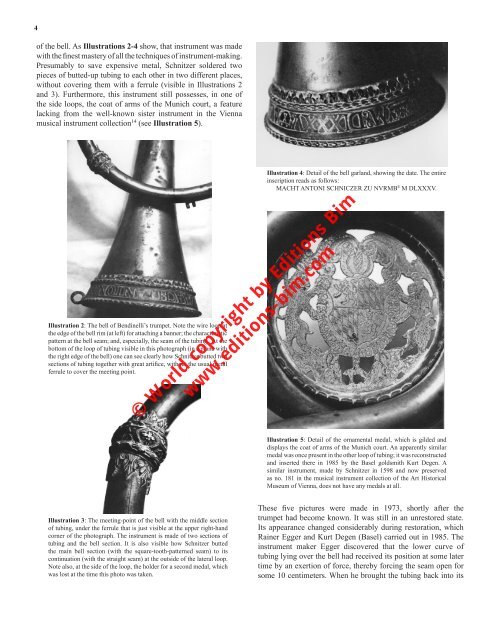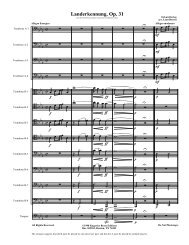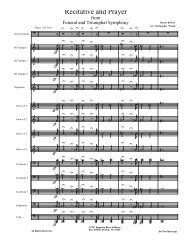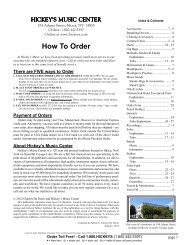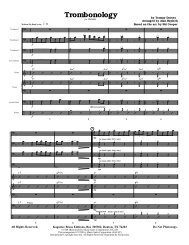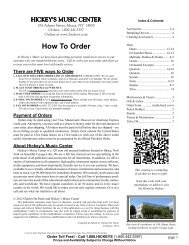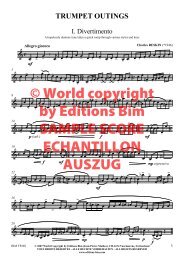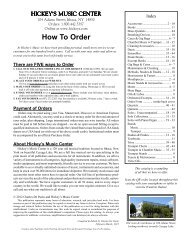Cesare Bendinelli: Tutta l'arte della Trombetta - Hickeys Music Online
Cesare Bendinelli: Tutta l'arte della Trombetta - Hickeys Music Online
Cesare Bendinelli: Tutta l'arte della Trombetta - Hickeys Music Online
Create successful ePaper yourself
Turn your PDF publications into a flip-book with our unique Google optimized e-Paper software.
4<br />
of the bell. As Illustrations 2-4 show, that instrument was made<br />
with the finest mastery of all the techniques of instrument-making.<br />
Presumably to save expensive metal, Schnitzer soldered two<br />
pieces of butted-up tubing to each other in two different places,<br />
without covering them with a ferrule (visible in Illustrations 2<br />
and 3). Furthermore, this instrument still possesses, in one of<br />
the side loops, the coat of arms of the Munich court, a feature<br />
lacking from the well-known sister instrument in the Vienna<br />
musical instrument collection 14 (see Illustration 5).<br />
Illustration 2: The bell of <strong>Bendinelli</strong>’s trumpet. Note the wire loop at<br />
the edge of the bell rim (at left) for attaching a banner; the characteristic<br />
pattern at the bell seam; and, especially, the seam of the tubing. At the<br />
bottom of the loop of tubing visible in this photograph (in a plane with<br />
the right edge of the bell) one can see clearly how Schnitzer butted two<br />
sections of tubing together with great artifice, without the usual metal<br />
ferrule to cover the meeting point.<br />
Illustration 4: Detail of the bell garland, showing the date. The entire<br />
inscription reads as follows:<br />
MACHT ANTONI SCHNICZER ZU NVRMB E M DLXXXV.<br />
© World copyright by Editions Bim<br />
www.editions-bim.com<br />
Illustration 5: Detail of the ornamental medal, which is gilded and<br />
displays the coat of arms of the Munich court. An apparently similar<br />
medal was once present in the other loop of tubing; it was reconstructed<br />
and inserted there in 1985 by the Basel goldsmith Kurt Degen. A<br />
similar instrument, made by Schnitzer in 1598 and now preserved<br />
as no. 181 in the musical instrument collection of the Art Historical<br />
Museum of Vienna, does not have any medals at all.<br />
Illustration 3: The meeting-point of the bell with the middle section<br />
of tubing, under the ferrule that is just visible at the upper right-hand<br />
corner of the photograph. The instrument is made of two sections of<br />
tubing and the bell section. It is also visible how Schnitzer butted<br />
the main bell section (with the square-tooth-patterned seam) to its<br />
continuation (with the straight seam) at the outside of the lateral loop.<br />
Note also, at the side of the loop, the holder for a second medal, which<br />
was lost at the time this photo was taken.<br />
These five pictures were made in 1973, shortly after the<br />
trumpet had become known. It was still in an unrestored state.<br />
Its appearance changed considerably during restoration, which<br />
Rainer Egger and Kurt Degen (Basel) carried out in 1985. The<br />
instrument maker Egger discovered that the lower curve of<br />
tubing lying over the bell had received its position at some later<br />
time by an exertion of force, thereby forcing the seam open for<br />
some 10 centimeters. When he brought the tubing back into its


